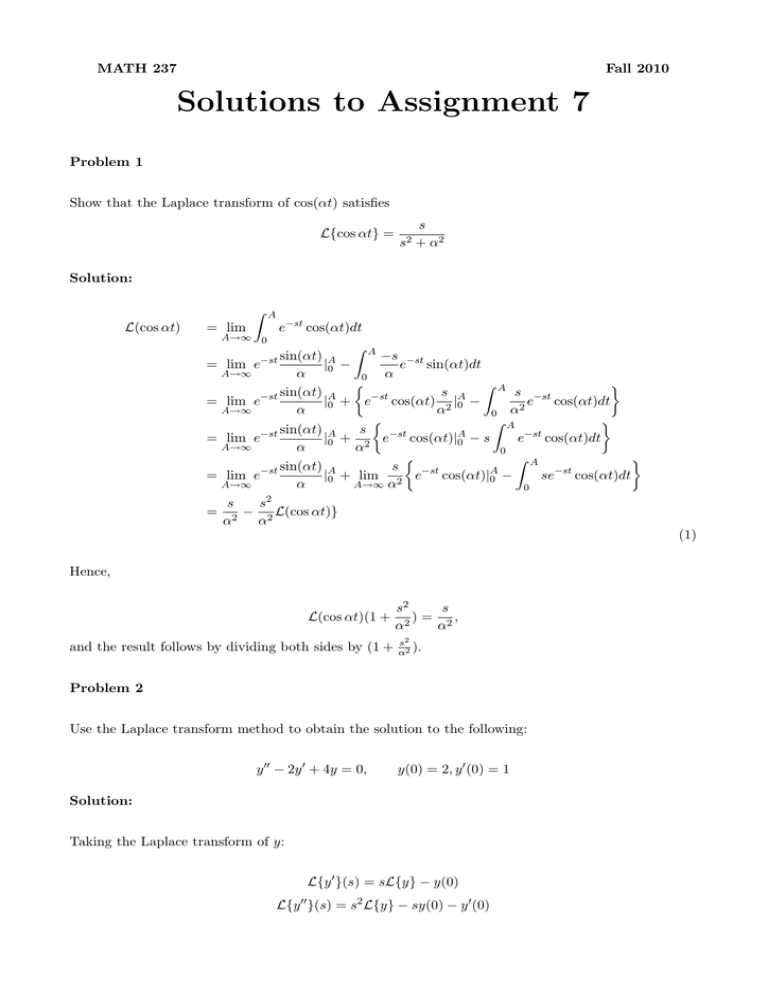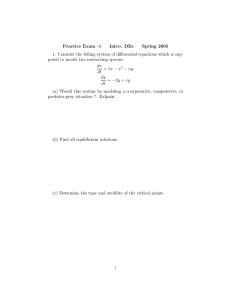Solutions7
advertisement

MATH 237
Fall 2010
Solutions to Assignment 7
Problem 1
Show that the Laplace transform of cos(αt) satisfies
L{cos αt} =
s2
s
+ α2
Solution:
L(cos αt)
Z
A
e−st cos(αt)dt
Z A
−s −st
−st sin(αt) A
|0 −
e sin(αt)dt
= lim e
A→∞
α
α
0
Z A
s −st
s A
−st
−st sin(αt) A
|0 + e cos(αt) 2 |0 −
e cos(αt)dt
= lim e
2
A→∞
α
α
0 α
Z A
s
−st sin(αt) A
−st
A
−st
= lim e
|0 + 2 e cos(αt)|0 − s
e cos(αt)dt
A→∞
α
α
0
Z A
s
−st sin(αt) A
−st
−st
A
= lim e
se cos(αt)dt
|0 + lim 2 e cos(αt)|0 −
A→∞
A→∞ α
α
0
s
s2
= 2 − 2 L(cos αt)}
α
α
= lim
A→∞ 0
(1)
Hence,
L(cos αt)(1 +
and the result follows by dividing both sides by (1 +
s
s2
) = 2,
2
α
α
s2
).
α2
Problem 2
Use the Laplace transform method to obtain the solution to the following:
y ′′ − 2y ′ + 4y = 0,
y(0) = 2, y ′ (0) = 1
Solution:
Taking the Laplace transform of y:
L{y ′ }(s) = sL{y} − y(0)
L{y ′′ }(s) = s2 L{y} − sy(0) − y ′ (0)
leads to:
L{y}(s2 − 2s + 4) = −2y(0) + y ′ (0)
Hence,
L{y}(s) = 2
4(s − 2)
s−1
1
=
−
s2 − 2s + 4
(s − 1)2 + 3 (s − 1)2 + 3
By observing that s − 1 term gives rise to a sine and a cosine, and a shift in the s−domain is equivalent
to multiplication by an exponential in the original function, we obtain,
√
√
1
y(t) = 2et cos( 3t) − √ et sin( 3t)
3
Problem 3
Suppose that
g(t) =
t
Z
f (τ )dτ.
0
If G(s) and F (s) are the Laplace transforms of g(t) and f (t), show that
G(s) = F (s)/s
Solution:
It could be noticed that
g(t) =
Z
t
f (s)ds
0
implies that g ′ (t) = f (t). Hence, F (s) = sG(s).
Problem 4
Suppose that
F (s) = L{f (t)},
exists for s > 0.
a) Show that if c > 0 then, for s > 0,
1 s
L{f (ct)} = F ( )
c c
b) Show that if k > 0 then, for s > 0,
L−1 {F (ks)} =
b) Show that if a, b > 0 are constants, then, for s > 0,
1 t
f( )
k k
L−1 {F (as + b)} =
1 −bt/a t
e
f( )
a
a
Solution:
a) In the following, let u = ct:
L(f (ct))(s)
A
= lim
Z
A/c
= lim
Z
A/c
= lim
Z
e−st f (ct)dt
A→∞ 0
A→∞ 0
e−s(u/c)f (u)
e−s/cu f (u)
A→∞ 0
du
c
du
c
1 s
= F( )
c c
(2)
b) This part follows from the result above, that is the Laplace transform of
F (ks)
c) Consider the Laplace transform
t
1
kf(k)
equals
k
k F (ks)
=
1
L( e−bt/a f (t/a))(s)
a
We know the following:
1
L{( e−bt/a f (t/a))}(s) =
a
=
lim
Z
aA
A→∞ 0
1
lim
a A→∞
Z
1
e−st ( e−bt/a f (t/a))
a
aA
e−(s+b/a)t f (t/a)
0
Now, defining a variable u = t/a, and applying the steps in part a, it follows that
1
L{( e−bt/a f (t/a))}(s)
a
Z aA
1
e(as+b)u f (u)adu
lim
a A→∞ 0
= F (as + b)
=
Problem 5
Compute the inverse Laplace transform of
s2 + 9s + 2
,
(s − 1)2 (s + 3)
where the inverse is a continuous function.
Hint: Use partial fraction expansion and the properties of the derivative of a Laplace transform.
Solution:
We express
a
b
c
s2 + 9s + 2
=
+
+
,
2
2
(s − 1) (s + 3)
(s − 1)
s−1 s+3
(3)
and find a = 2, b = 3, c = −2
The inverse transform leads to:
2et + 3tet − 2e−3t
Problem 6
The transfer function, H(s), of a linear system is defined as the ratio of the Laplace transform of the
output y(t) to the Laplace transform of the input function g(t), under the assumption that all the
initial conditions are set to zero. If the linear system is governed by a differential equation:
ay ′′ + by ′ + cy = g(t)
Verify that the transfer function is given by:
H(s) =
as2
1
+ bs + c
Now suppose the Laplace transform of g(t) satisfies G(s) = 1. In this case, you can see that y(t) is
the inverse Laplace of the transfer function, which we denote by h(t). But, G(s) = 1 is the Laplace
transform of the impulse. This is why h(t) is called the impulse response of the system.
Solution:
Taking the Laplace transform of both sides, and observing that the initial conditions are set to zero,
we obtain
L(ay ′′ + by ′ + cy) = L(g)
and
L(y) =
(as2
L(g)
.
+ bs + c)
(as2
1
+ bs + c)
Hence, if G(s) = 1, we obtain:
H(s) =
H(s) is the transfer function; it multiplies the Laplace transform of the input to generate the Laplace
transform of the output at a given value of s.
* * * Have a good, well-deserved winter break * * *



